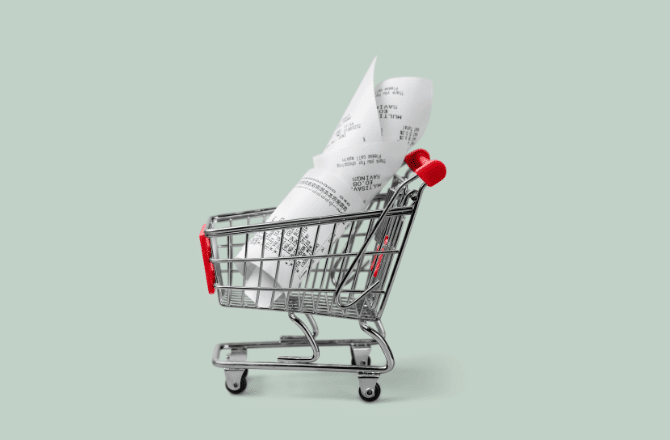How Does Invoice Purchasing Work?
If you’re a business that uses invoicing as part of your regular billing, you know the hassle of waiting for payment.
Clients who pay the normal “on time” invoice still have 30 days. Slow payers can take up to 90 before paying in full. The average net 30 invoice gets paid in around 50 days, and average businesses have more than $150,000 in unpaid invoices sitting in their accounts receivable.
Every business can relate to the feeling of trying to craft a gentle, yet effective payment reminder email. You value your customer relationships, but you also need to make sure your clients are paying you in a timely manner.
It’s a necessary headache if you want to work with large corporations and government entities. But when you need money fast, it doesn’t help that you have hundreds of thousands of dollars in outstanding invoices. You need the cash, not the accounts receivable.
A merchant cash advance is an option, but the fees can be astronomical. Still, it may be your best choice …
Unless, of course, you can get someone to purchase your invoices.
What Is Invoice Purchasing?
Invoice purchasing is an alternative income stream you can tap into when you need working capital fast.
Your business sells the active invoices to a purchaser, who pays you instantly for the amount outstanding. They then collect the money due from the client directly.
It sounds simple, and for the most part, it is. Before you decide whether this alternative funding source is for you, you should know the basics of how invoice purchasing works.
Invoice Purchasing vs. Merchant Cash Advances
Invoice purchasing and merchant cash advances are often used interchangeably, but they’re not the same thing. Both offer a way to get working capital quickly, yet each has its own advantages and disadvantages.
An invoice purchase is not a loan that has repayment terms. It’s a type of business financing that happens when you “sell” your current outstanding invoices to a third party.
The invoice purchasing company, also called a factoring company, pays you a substantial portion of the amount on the invoice. Then, they collect the outstanding bill from the customer directly.
A Summary of Invoice Purchasing
In this type of financing, you don’t have to wait for your clients to pay their bills, which can take months. However, you give up control of some or all the invoices in your accounts receivable to the third party. But, you do have a full say in which invoices you turn over for this accounts receivable factoring.
Next, the company reviews the clients’ financial history and decides whether to approve the invoice for purchasing or not.
It’s a smart idea to use invoice purchasing when your company relies primarily on billing clients. While you’re waiting for them to pay, your expenses are still due. An invoice purchase frees up cash flow and lets you cover your bills on time.
What is a Merchant Cash Advance?
A merchant cash advance (MCA) is a funding source that gives you working capital to use however you want. A lender reviews your accounts receivable, then gives you funds in exchange for a specified percentage of future sales.
It could be a great deal, except for the hefty interest rates and extra fees that come along with the package.
Since most of the businesses who turn to MCAs for funding don’t have stellar credit, these fees are a way for the lender to cover their bases — in case they don’t get paid back.
A Summary of Merchant Cash Advances
The best part about a merchant cash advance is that you can usually have your funds in one business day. For business owners in an emergency situation, this financial solution is tempting.
The merchant cash advance companies also use past sales — not a credit score, bank statements, or current rough spot — to make their lending decision. There’s very little paperwork to complete, and you can find out if you’re approved within minutes.
Merchant cash advances work similarly to a payday loan, though. Yes, you have fast cash, but it comes with a high price. Your future credit card sales aren’t wholly yours; they belong to the MCA providers.
The Disadvantages of MCA Funding Options
In fact, financial experts will tell you that an MCA should be your last resort, even behind credit cards.
An average card’s interest rate for someone with a poor rating is around 29%. An MCA’s fees and interest come up to closer to 80% and often closer to 350%.
Similar to a payday advance, a merchant cash advance often puts the borrower in a vicious cycle of lending in order to make their payments.
The repayment terms are based on your daily credit card sales, and since the funds come straight out of your bank account, you can’t defer the weekly debt. The lender pulls a fixed payment from your credit card transactions.
Before you decide to use an MCA, make sure you’ve exhausted every other funding alternative first. A line of credit, term loan, or a small business loan are all preferable over the dangers of a merchant cash advance.
If you need cash fast or have bad credit, invoice purchasing is a wise business funding avenue.
Check out: Simple Small Business Solutions You Actually Need
Benefits of Small Business Invoice Purchasing
As a financial alternative to a business loan or credit card debt, invoice purchasing holds its own.
It solves the problem of fast cash by freeing up working capital without a cycle of repayment. There’s no concern over losing money on future purchases as a merchant cash advance requires, and the terms are more affordable.
Another benefit of using invoice purchasing over other financing options is that the application process doesn’t focus on your business. Some factors come into play, of course, such as how long you’ve been operating. But overall, the bulk of the credit decision is determined by the client’s financial history, not yours.
Working With Your Suppliers and the Third Party Lender
Some business owners worry about handing over their clients’ information to a third party, which is understandable. However, for the most part, your suppliers will appreciate longer payment terms and not feeling pressured to pay their invoice immediately.
At the same time, you have the capital you need to pay your own suppliers, building your credit standing with them. Over time, this cycle of providing a service, selling an invoice, and getting upfront money can benefit everyone in the supply chain.
Unlike with a bank loan, there’s no hit to your rating on the credit bureaus with invoice purchasing. And your credit card receipts are all yours. It’s a solution with lots of advantages.
The Step-By-Step Details: How an Invoice Purchase Works
The process of an invoice purchase is designed to be smooth and efficient. People who use this small business financing usually need money faster than a business line of credit or loan can provide them.
While every lending provider has its own procedures, here’s a breakdown of what a typical invoice purchase transaction looks like:
Step One
First, the seller provides a good or service to their customer and invoices them as usual.
Step Two
Next, the seller chooses invoices that they want to receive cash upfront for and completes an online application to an invoice factoring company (the purchaser).
Step Three
The purchaser reviews the invoices offered and sends an approval or denial back to the seller. Along with the approval, the company includes its factor rate and fees.
Step Four
Upon agreement, the purchaser pays for the invoices minus a holding amount and the fees. Sellers can expect to receive 80-90% of their invoices’ value upfront.
Step Five
The purchaser then collects the invoiced amount from the client. If there is any remaining invoice amount after fees, the excess returns to the seller.
Because the process requires minimal effort on the business owner’s part, it’s an easy way to get cash fast. And when you find an invoice purchasing company with reasonable rates, the cost is often offset by the fact that you don’t have credit card processing fees to deal with.
Related: How to Handle Short-Paid Invoices
Who Can Benefit from Invoice Purchasing?
Small and medium business owners who need immediate cash flow don’t always have the credit or qualifying factors for an SBA or traditional bank loans. A short-term loan is easier to get approved for, but then you’re stuck in the repayment cycle again.
As with any outside funding source, the key is to be cautious and aware of what you’re getting into. Invoice purchasing is a better alternative than a business cash advance, but it’s not something to depend on for your monthly payments.
When Selling Your Invoices is the Smart Thing to Do
This financial solution is helpful for business owners who need to free up working capital in a hurry (and who use invoices as part of their billing system). If you have clients that you know will pay, but not as quickly as you need them to, you have the option to sell the invoice.
Since there is always a fee involved, it’s best to keep your invoices in-house. Still, invoice purchasing is a financially sound way to get through a slow period as a holdback to avoid late fees on short-term expenses.
Selling an invoice to pay off a loan with a high-interest rate is another good reason to work with a purchasing company. And consider it over a business credit card if there’s a once-a-year sale you can invest in now to reap the financial benefits in the future.
In fact, any situation in which you can sell an invoice now to save money later is an advantageous transaction.
See also: What Your Business Can Do to Speed Up Invoice Payments
Features of a Reputable Invoice Purchasing Business
Just as you’d evaluate the merchant cash providers and their terms before agreeing to work with them, you should do the same with your invoice purchasing company.
Selling your invoice to the wrong lender can cost you substantially. It will also give you a bad taste for the financing solution. Whereas finding a reasonable company creates a partnership you can turn to when you need fast funds.
Check through the FAQ page for these features as you’re searching for a reputable invoice purchasing company:
1. The Rates and Pricing
Invoice acceleration companies like Now have flat upfront fees rather than the daily fees charged by other lenders. Regardless of how long the invoice is outstanding, you only pay one fee. This can save you a lot of money if the client takes a while to pay the lender.
2. The Company’s Longevity and Stability
Startups have to get their business somewhere, but when it comes to dealing with your money …
You want someone established with a good overall reputation.
3. Flexible Options for Your Invoice Choices
Cherry-picking your invoices and only selling the probable bad debts won’t let you develop a good working relationship with the lender. But they shouldn’t be able to take over your accounts receivable and get access to all your invoices.
Find a company that lets you retain ownership, and work with them to learn the best ways to select invoices to sell.
4. Reasonable Payment Terms
You don’t want to end up in a long-term contract or get penalized when the client doesn’t pay their invoice. Some invoice factoring businesses have a monthly minimum they require you to send. This forces you to sell invoices and pay fees when you didn’t need the cash at the time.
5. Positive Client Reviews
Don’t forget to read the client reviews. When most of the previous clients recommend the company, you can go into the transaction feeling comfortable.
There will usually be a handful of negative reviews, especially when you’re dealing with lending money. If the positives well outweigh the negatives, the company is likely legitimate.
An invoice purchaser that ticks all these factors — and has reasonable financing rates — could be the start of a very beneficial working relationship.
Related: Your Full Guide to Small Business Invoice Factoring
Conclusion
Small business owners who need money in a pinch don’t have to resort to using merchant cash advance providers with outrageous repayment terms. Even if your business credit is less than perfect, an invoice purchasing solution could be your best bet.
You get most of the amount due in one lump sum. The company collects from the client, and there’s no worry about how you’ll pay them back in the future. Your credit and debit card sales are all yours, and the control stays firmly in your hands.
See if you qualify for accelerated invoice payments by setting up your NowAccount!






